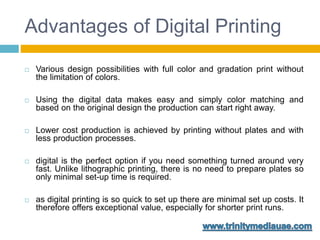Digital Printing Fundamentals Explained
Digital Printing Fundamentals Explained
Blog Article
8 Simple Techniques For Digital Printing
Table of ContentsA Biased View of Digital PrintingThe Only Guide to Digital PrintingUnknown Facts About Digital PrintingEverything about Digital PrintingNot known Facts About Digital PrintingWhat Does Digital Printing Mean?
Variable data printing, such as direct mail with personalized codes and addresses, is ideally fit for electronic printing. Digital fast printing only requires 4 steps of design, review, printing and binding to get every little thing done. Digital fast printing has an unmatched benefit: print on demand.According to PMMI, digital printing permits brand names and makers to respond rapidly to customer demands while enhancing the supply chain, decreasing warehousing price and waste, and taking pleasure in faster time to market. That all sounds fantastic, however how does this technology do all that? The major differentiator of these innovations is that there are no set-up fees and no plates with digital printing.
Getting My Digital Printing To Work
This results in quicker turn-around time and lowers expense when utilizing digital printing.
Digital printing is extremely versatile, so it's very easy to make modifications to the bundle layout promptly. It all goes back to the plates.
With conventional printing approaches, short-run printing is simply not feasible. Since a wonderful design can make or break your item, electronic printing continually develops premium, clear and colorful graphics each time.
Digital printing is the process of printing digital-based images straight onto a range of media substrates. There is no need for a printing plate, unlike with balanced out printing. Digital documents such as PDFs or desktop posting data can be sent straight to the electronic printing machine to publish theoretically, photo paper, canvas, fabric, synthetics, cardstock and other substrates.
Digital Printing Can Be Fun For Anyone
According to PMMI, electronic printing allows brand names and suppliers to react swiftly to consumer demands while boosting the supply chain, decreasing warehousing cost and waste, and taking pleasure in faster time to market. That all sounds great, however just how does this modern technology do all that? The major differentiator of these technologies is that there are no set up charges and no plates with electronic printing.
According to Wikipedia, the biggest distinction between digital printing and conventional approaches such as lithography, flexography, gravure, or letterpress is that there is no need to change printing plates in electronic printing, whereas in these analog printing techniques the plates are consistently changed. This leads to quicker turn-around time and reduces cost when making use of digital printing.

The Of Digital Printing
With conventional printing methods, short-run printing is just not feasible. Since a terrific layout can make or break your item, electronic printing consistently creates high-quality, clear and vivid graphics each time.

According to PMMI, digital printing enables brands and suppliers to react quickly to client needs while boosting the supply chain, decreasing warehousing expense and waste, and taking pleasure in faster time from this source to market. That all sounds excellent, however how does this innovation do all that? The significant differentiator of these technologies is that there are no set up charges and no plates with electronic printing.
The Facts About Digital Printing Revealed
According to Wikipedia, the best difference between electronic printing and typical approaches such as lithography, flexography, gravure, or letterpress is that there is no requirement to change printing plates in electronic printing, whereas in these analog printing techniques home plates are repeatedly changed. This causes quicker turn-around time and lowers price when utilizing digital printing.
Speedy production suggests obtaining your product to market much faster. It also suggests it's simpler and faster to make adjustments in the future, when you alter a dish, include a SKU, or create seasonal packaging. Digital printing is very flexible, so it's easy to make adjustments to the package design quickly. It all returns to home plates.

The Ultimate Guide To Digital Printing
Digital printing is the process of printing digital-based images straight onto a variety of media substratums. There is no demand for a printing plate, unlike with countered printing. Digital data such as PDFs or desktop computer publishing files can be sent out directly to the electronic printing press to print on paper, image paper, canvas, textile, synthetics, cardstock and various other substrates.
Report this page